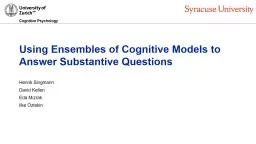

Henrik Singmann David Kellen Eda Mızrak Ilke Ö ztekin CogSci Theory Data and Models Goals Develop accurate characterizations of observed behavior in terms of latent cognitive processes ID: 801241
Download The PPT/PDF document "Using Ensembles of Cognitive Models to A..." is the property of its rightful owner. Permission is granted to download and print the materials on this web site for personal, non-commercial use only, and to display it on your personal computer provided you do not modify the materials and that you retain all copyright notices contained in the materials. By downloading content from our website, you accept the terms of this agreement.
Slide1
Using Ensembles of Cognitive Models to Answer Substantive Questions
Henrik SingmannDavid KellenEda MızrakIlke Öztekin
Slide2CogSci
: Theory, Data, and ModelsGoals:Develop accurate characterizations of observed behavior in terms of latent cognitive processes.
Describe differences between groups or conditions in terms of latent processes. For example:
Are older adults more risk averse or cautious than younger adults?
Do preschool children exhibit a "yes" response bias to yes/no questions?
Do amnesic patients have both impaired implicit and explicit memory?
Does emotional material elicit differences in memorability or in response bias?
Does low working memory (WM) capacity also affect memory performance for low WM load tasks?
Cognitive measurement models
:
For example: Prospect theory, Ratcliff diffusion model, process dissociation procedure, signal detection theory
Instantiate relationship with observed data in clear and general way
Privileged approach for evaluating contribution of latent processes to observed behavior
Ensemble posterior model probabilities
combine multiple measurement models for answering substantive questions.
Slide3Latent Processes in Detection Experiments
2 independent data points:Hits: P(
T
|target
)
False alarm: P(
T|lure)Two latent process:Sensitivity / discriminability: higher sensitivity: ↑ hits; ↓ false alarmsResponse bias:stronger bias towards T: ↑ hits; ↑ false alarms
m
r
b
v
Study List
#&#
v
y
500
ms
each
target
T
L
T
L
lure
Signal-detection theory model
:
sensitivity
response bias
"T"
"L"
signal strength
lure
target
Slide4SDT with 2 Groups: 4 Possible Models
Two groups
: low WM capacity and high WM capacity
No differences between groups:
,
Groups differ only in sensitivity:
,
Groups differ only in response bias:
,
Groups differ in both, sensitivity and response bias:
,
Model selection:AIC, BIC, or NMLDIC, WAIC, or PSIS-LOOCross-validationBayes factors or posterior model probabilities
"T"
"L"
signal strengthluretarget
Signal-detection theory model: sensitivity response bias
Slide5Bayesian Model Selection I
Bayesian statistical framework: quantification of uncertainty with probabilities
Data
Parameters
Model
Likelihood function
Prior distribution of parameters
Posterior distribution:
unnormalized posterior
(approximated via MCMC)
marginal likelihood, more
difficult to obtain
can be approximated via bridge sampling
(e.g., Gronau, Singmann, & Wagenmakers, 2017)
Slide6Bayesian Model Selection II
For
models:
Marginal likelihood:
Posterior model probabilities:
Problem: Marginal likelihood based model selection
extremely sensitive
to parameter priors.
Possible exception when all considered models are nested within one full model: Jeffrey's (1961)
default priors
Difference parameter can be normalized on variability parameter.
Allows parameter prior for difference parameter on normalized scale.
Slide7SDT with 2 Groups: 4 Possible Models
Two groups
: low WM capacity and high WM capacity
No differences between groups:
,
Groups differ only in sensitivity:
,
Groups differ only in response bias:
,
Groups differ in both, sensitivity and response bias:
,
Model selection:Posterior model probabilities
"T"
"L"
signal strengthluretarget
Signal-detection theory model: sensitivity response bias
40%
4
5%
8
%
7%
Slide8Signal Detection Theory Model and 2-High Threshold Model
"T"
"L"
lure
target
Signal-detection theory model
:
sensitivity
response bias
luretarget
"T""T"
"L""L"
2-high threshold model
:
sensitivity
response bias
signal strength
Slide9Signal Detection Theory Model and 2-High Threshold Model
Two groups: low WM capacity and high WM capacity
No differences between groups
Groups differ only in sensitivity
Groups differ only in response bias
Groups differ in both, sensitivity and response bias
"T"
"L"lure
targetSignal-detection theory model: sensitivity response bias
luretarget"T"
"T""L"
"L"
2-high threshold model
:
sensitivity
response bias
signal strength
,
,
,
,
,
,
,
,
4
0%
4
5%
8
%
7%
30
%
25
%
28
%
17
%
Slide10Signal Detection Theory Model and 2-High Threshold Model
Two groups: low WM capacity and high WM capacity
No differences between groups
Groups differ only in sensitivity
Groups differ only in response bias
Groups differ in both, sensitivity and response bias
"T"
"L"lure
targetSignal-detection theory model: sensitivity response bias
luretarget"T"
"T""L"
"L"
2-high threshold model
:
sensitivity
response bias
signal strength
,
,
,
,
,
,
,
,
4
0%
4
5%
8
%
7%
30
%
25
%
28
%
17
%
Ensemble Posterior Model Probabilities
35
%
3
5%
18
%
12%
Slide11Example Experiment: WM Capacity and Detection Performance
m
r
b
v
Study List
#&#
v
y
500
ms
each
target
T
L
T
L
lure
Threshold Model
Signal-Detection Model
Observed Data
Accuracy
Slide12Threshold Model
Signal-Detection Model
Observed Data
Slide13Example Experiment: Ensemble Posterior Model Probabilities
Threshold Model
Signal-Detection Model
Slide14Ensemble Posterior Model Probabilities
"All models are wrong" (Box, 1976). Substantive conclusion should be as model independent as possible.Different model classes decompose data into same latent cognitive processes.
Ensemble posterior model probabilities allow inferences regarding
substantive questions across
ensembles of model classes.
Why not simply estimate posterior model probabilities across model classes?
Marginal likelihood based model selection extremely sensitive to parameter priors.Parameter priors mostly play auxiliary or nuisance role. Difficult or often impossible to come up with parameters priors which allow model selection in a fair manner (but see Lee & Vanpaemel, 2017; Vanpaemel & Lee, 2012).Marginal likelihood based model selection using Jeffrey's default priors within model class sidesteps many of these problems.